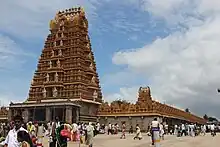| Nanjundeshwara Temple | |
|---|---|
ನಂಜುಂಡೇಶ್ವರ ದೇವಸ್ಥಾನ | |
 | |
| Religion | |
| Affiliation | Hinduism |
| District | Mysore |
| Deity | Nanjundeshwara Swami (Shiva) |
| Location | |
| Location | Nanjanagudu |
| State | Karnataka |
| Country | India |
| Geographic coordinates | 12°7′8″N 76°41′33″E / 12.11889°N 76.69250°E |
| Architecture | |
| Type | Temple |
| Website | |
| https://nanjangudtemple.kar.nic.in | |
The Nanjundeshwara Temple (also called Srikanteshwara Temple) is an ancient temple dedicated to Shiva in the Hindu pilgrimage town of Nanjanagudu in Karnataka, India.[1] It is located on the right bank of the Kapila River, a tributary of the Kaveri River. Nanjanagudu is also known as "Dakshina Kashi" or "Kashi of South".[2][3]
Nanju in Kannada means "to poison". The name Nanjundeshwara means the "God who Drank the Poison" (halāhala, a word that has its origins in the legend of the Great Churning of the Ocean of Milk); thus, the town got the name "Nanjanagudu" which means "the abode of the god Nanjundeshwara".[4][5][6]
The temple's Dodda Jaathre[7] festival attracts thousands of devotees. The festivities in the fair include five colorful chariots pulled by devotees on a path called the ratha beedi. Parasurama Temple is near Nanjundeshwara Temple.
The nine-storied, 120-foot-tall temple gopuram (gateway tower) and its extensive exterior was built by Devarajammanni, the queen of the Mysore king Krishnaraja Wadiyar III.[8]
History
Nanjungud is mentioned as Sri Garalapuri, in the Shiva Purana.[9] It is said that the legendary holy place is the abode of Shiva in southern India. It is also referred to as "Dakshina Kasi", where the god appeared at the plea of his devotees, the Devas, and sage Narada. The demon Keshi obtained a boon from Brahma and Vishnu by which they would not be able to kill him. He assumed that with this boon, he was as good as immortal and began troubling the people, the Devas, and the sages. At last, Narada and the Devas pleaded with Shiva to save everyone. He appeared in Garalapuri Sri Kshetra (present Nanjungud) and killed Keshi. He further assured that his Ansh (a part of his divine self) would always remain here and bless humanity; the place henceforth would be a papa vinashini ('remover of sins'). After bathing in the holy river of Kabini, every human praying to Lord Srikanteshwara or Nanjundeshwara (Shiva) of Nanjungud would be rid of sins and blessed by the god.
Sage Parashuram, after beheading his mother as per his father Sage Jamadagni's orders, wanted to undo his sins from "Matru Hatya" (his mother's murder). Per Narada's advice, he reached Garalapuri (Nanjangud) and prayed to Sri Nanjundeshwara Swamy. Shiva appeared and advised him to build a mantapa and perform pooja to the Shivlinga. While clearing the shrubs with his parashu (axe),[10] Parashuram's axe unintentionally hit the Shivlinga, and the tip of the Shivlinga began to bleed. Sage Parashuram felt very guilty and said, "I have committed another unforgivable sin; only by killing myself shall I be relieved from all my sins", and prepared to kill himself. Shiva appeared and blessed Sage Parashuram and told him to apply wet mud upon the Shivlinga (the mud of Sri Nanjangud has immense healing powers). The Shivlinga stopped bleeding. Lord Shiva advised Parashuram to build the mantapa and continue his penance. Finally, Sage Parashuram was relieved from all his sins and blessed with immortality.
The Goddess Parvati,[11] consort of Shiva, wanted to visit this holy place, and so he brought her to Garalapuri Nanjangud. When she went to the Kabini River and bent down to touch the water, a gemstone bead (mani) fell off from her crown into the water. Lord Shiva was pleased and declared, "Devi, until now, the place had my divine blessings and presence; from this moment, it shall have your presence, grace and blessings, too. It shall also be called Dakshina Manikarnika Ghat".
During the reign of King Tipu Sultan, his royal elephant became blind. As per the advice of his minister, Sri Poornayya, Tipu sent the elephant to the Nanjundeshwara Swamy Temple and performed 48 days of rituals. On the 48th day, the elephant's vision was restored. Tipu Sultan offered the emerald green Shivlinga as a token of gratitude to Sri Nanjundeshwara Swamy and called Lord Shiva "Hakim Nanjunda" (healer).[12]
Gallery
 View of gopura from inside
View of gopura from inside Large pillared mantapa with sala towers
Large pillared mantapa with sala towers Open mantapa with sala roofs
Open mantapa with sala roofs Close up view of sala tower over mantapa
Close up view of sala tower over mantapa Pillared entrance to temple
Pillared entrance to temple Close up view of pillared entrance to temple
Close up view of pillared entrance to temple_of_Srikanteshwara_temple_complex_at_Nanjangud.JPG.webp) Yali pillars in the mahadwara
Yali pillars in the mahadwara_in_the_Srikanteshwara_temple_at_Nanjangud.JPG.webp) Kannada inscription (1517 CE) of King Krishnadevaraya's father-in-law
Kannada inscription (1517 CE) of King Krishnadevaraya's father-in-law Deity sculpture
Deity sculpture Ganesha sculpture
Ganesha sculpture Deity sculpture
Deity sculpture Shree Veerabhadreshwara sculpture
Shree Veerabhadreshwara sculpture Deity sculpture
Deity sculpture Deity sculpture
Deity sculpture Deity sculpture
Deity sculpture Decorative pillars
Decorative pillars
See also
References
- ↑ "Nanjundeshwara temple, Nanjangudu".
- ↑ "Nanjangud car festival held with traditional fervour". The Hindu. 16 March 2022.
- ↑ Architecture of the Famous Srikanteshwara Temple
- ↑ Architecture of Karnataka#Nanjangud Temple
- ↑ Sri Srikanteshwara Temple in Nanjangud.Info
- ↑ Tourism page in Nanjangud Town Municipal Council
- ↑ madur (17 March 2019). "Dodda Jatre – The Festival Of Srikanteshwaraswamy Temple In Nanjangud". Karnataka.com. Retrieved 5 December 2022.
- ↑ "Srikanteshwara (Nanjundeswara) Temple". Mysuru District Website.
- ↑ www.wisdomlib.org (7 August 2018). "The Shiva Purana". www.wisdomlib.org. Retrieved 5 December 2022.
- ↑ "Parashu Weapon - The Divine Axe Weapon of Parshuram and Shiva". Retrieved 5 December 2022.
- ↑ Garden, Goddess (9 November 2018). "The Hindu Goddess Parvati". The Goddess Garden. Retrieved 5 December 2022.
- ↑ "Where Tipu Worshipped". The New Indian Express.